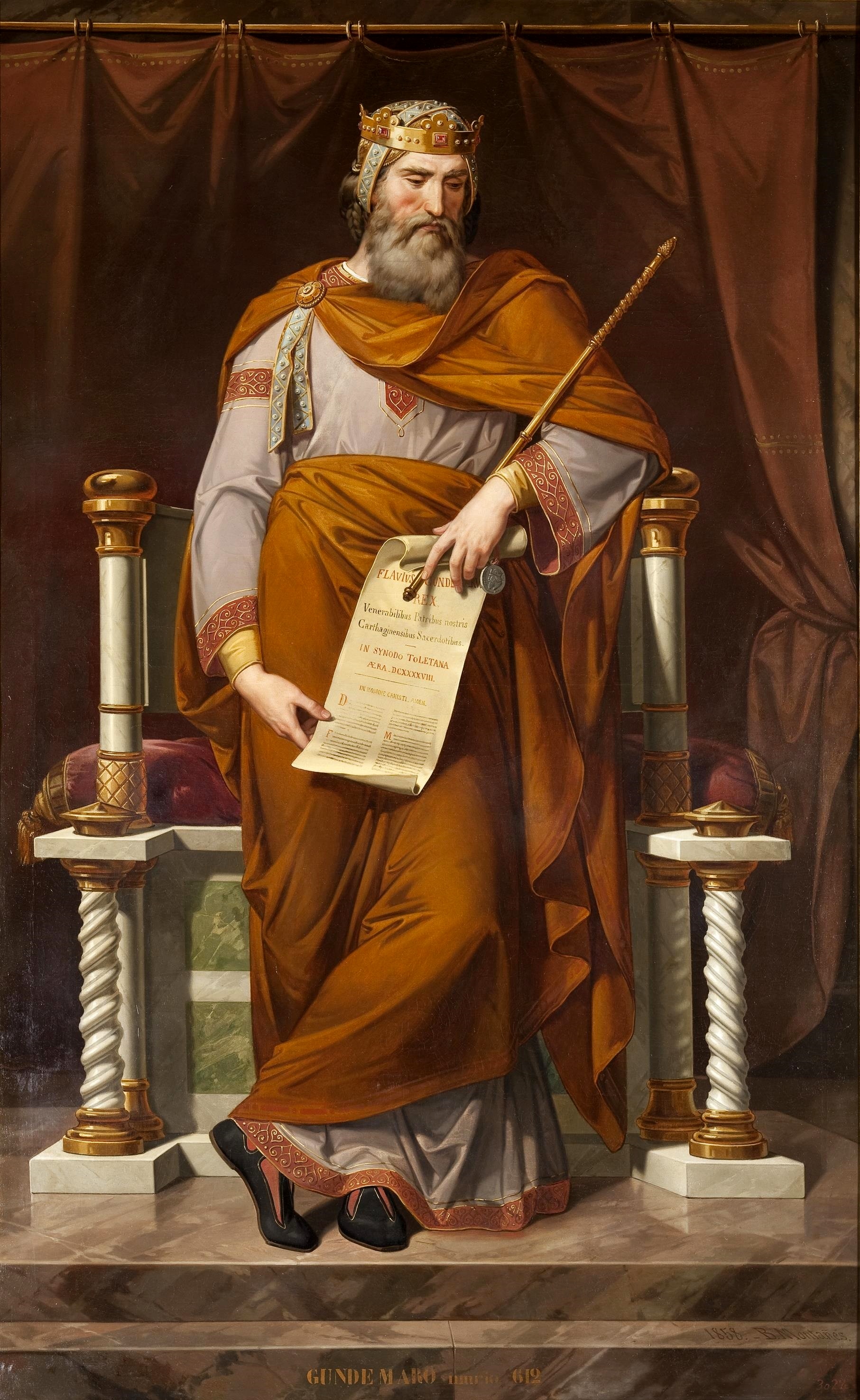Gundemar on:
[Wikipedia]
[Google]
[Amazon]
 Gundemar was a
Gundemar was a
p. 173. He was succeeded by
Coins of King Gundemar
7th-century Visigothic monarchs Gothic warriors 612 deaths Year of birth unknown {{europe-royal-stub
 Gundemar was a
Gundemar was a Visigothic
The Visigoths (; la, Visigothi, Wisigothi, Vesi, Visi, Wesi, Wisi) were an early Germanic people who, along with the Ostrogoths, constituted the two major political entities of the Goths within the Roman Empire in late antiquity, or what is kno ...
King
King is the title given to a male monarch in a variety of contexts. The female equivalent is queen, which title is also given to the consort of a king.
*In the context of prehistory, antiquity and contemporary indigenous peoples, the tit ...
of Hispania
Hispania ( la, Hispānia , ; nearly identically pronounced in Spanish, Portuguese, Catalan, and Italian) was the Roman name for the Iberian Peninsula and its provinces. Under the Roman Republic, Hispania was divided into two provinces: Hispania ...
, Septimania
Septimania (french: Septimanie ; oc, Septimània ) is a historical region in modern-day Southern France. It referred to the western part of the Roman province of Gallia Narbonensis that passed to the control of the Visigoths in 462, when Septima ...
and Galicia (610–612).
Reign
Gundemar continued a policy of amity withClotaire II
Chlothar II, sometime called "the Young" ( French: le Jeune), (May/June 584 – 18 October 629), was king of Neustria and king of the Franks, and the son of Chilperic I and his third wife, Fredegund. He started his reign as an infant under the r ...
of Neustria
Neustria was the western part of the Kingdom of the Franks.
Neustria included the land between the Loire and the Silva Carbonaria, approximately the north of present-day France, with Paris, Orléans, Tours, Soissons as its main cities. It later ...
and Theodobert II
Theudebert II () (c.585-612), King of Austrasia (595–612 AD), was the son and heir of Childebert II. He received the kingdom of Austrasia plus the cities (''civitates'') of Poitiers, Tours, Le Puy-en-Velay, Bordeaux, and Châteaudun, as well ...
of Austrasia
Austrasia was a territory which formed the north-eastern section of the Merovingian Kingdom of the Franks during the 6th to 8th centuries. It was centred on the Meuse, Middle Rhine and the Moselle rivers, and was the original territory of the F ...
. To this end, he sent grand sums of money to support their cause against their relative (cousin and brother, respectively) Theuderic II
Theuderic II (also spelled Theuderich, Theoderic or Theodoric; in French, ''Thierry'') (587–613), king of Burgundy (595–613) and Austrasia (612–613), was the second son of Childebert II. At his father's death in 595, he received Guntram's k ...
of Burgundy
Burgundy (; french: link=no, Bourgogne ) is a historical territory and former administrative region and province of east-central France. The province was once home to the Dukes of Burgundy from the early 11th until the late 15th century. The c ...
. At other times, he pursued a hostile policy against Brunhilda Brunhilda may refer to:
* Brunhild, a figure in Germanic heroic legend
* Brunhilda of Austrasia (c. 543–613), Frankish queen
* ''Brunhilda'' (bird), a genus of birds
See also
*
*
* Broom-Hilda, an American newspaper comic strip
* Broomhild ...
.
According to Isidore of Seville
Isidore of Seville ( la, Isidorus Hispalensis; c. 560 – 4 April 636) was a Spanish scholar, theologian, and archbishop of Seville. He is widely regarded, in the words of 19th-century historian Montalembert, as "the last scholar of ...
, Gundemar made one expedition against the Basques, then besieged the Byzantines in the next. He died a natural death in Toledo, probably in February or March 612. The ''Chronica Regum Visigotthorum'' records that Gundemar reigned for one year, ten months and 14 days.''Chronica Regum Visigotthorum'', España Sagrada Tomo Ip. 173. He was succeeded by
Sisebut
Sisebut ( la, Sisebutus, es, Sisebuto; also ''Sisebuth'', ''Sisebur'', ''Sisebod'' or ''Sigebut'') ( 565 – February 621) was Visigothic Kingdom, King of the Visigoths and ruler of Hispania and Septimania from 612 until his death.
Biography
H ...
.
He was married to Hildoara
Hildoara (6th-century – fl. 610) was a Visigoth queen consort by marriage to king Gundemar (610–612).
She is described as a pious follower of the Nicene Christianity
The original Nicene Creed (; grc-gre, Σύμβολον τῆς Νικα ...
.
Legacy
The towns of Gondomar in Portugal and in Galicia are named after him.References
External links
Coins of King Gundemar
7th-century Visigothic monarchs Gothic warriors 612 deaths Year of birth unknown {{europe-royal-stub